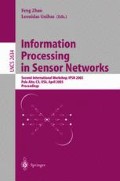Abstract
In this paper we present a distributed, application-morphable, algorithm for waking up appropriate sensor nodes in a heterogeneous sensor network. We assume a sensor field consisting of a large number of low power, limited functionality, tripwire nodes and a smaller number of powerful, energy-hungry, tracker nodes. Our problem is that when an event is detected by a set of tripwire nodes a specific number of appropriate tracker nodes needs to be woken up. These tracker nodes will subsequently collaborate to perform the sensing task required by the application. Waking up non-suitable tracker nodes or employing more trackers than necessary for a specific task, can lead to significant waste of network resources (e.g. energy). The application indicates the number of nodes that are needed for a sensing task, as well as an optimization function to be used by the algorithm. Therefore, our algorithm is isolated from most application details and is simple and general enough to accommodate a wide range of sensing applications. We prove that our algorithm converges to a uniform optimal global decision for specific classes of optimization functions. Furthermore, we show that it is fast enough (< 100ms) to be practical for most sensing applications and exhibits good performance in terms of total messages exchanged. Finally, we demonstrate that our algorithm is very robust, managing to retain its correct and efficient behavior for a wide range of scenarios, even under hostile environmental conditions (e.g. link loss probabilities up to 35%).
This work is supported by the DARPA Power Aware Computing and Communication Program under contract no. F33615-C-00-1633.
Access this chapter
Tax calculation will be finalised at checkout
Purchases are for personal use only
Preview
Unable to display preview. Download preview PDF.
References
J. Kahn, R.H. Katz, and K. Pister, “Emerging Challenges: Mobile Networking for Smart Dust,” in Journal of Communication and Networks, Sept. 2000, pp. 188–196.
F. Zhao, J. Shin, and J. Reich, “Information-Driven Dynamic Sensor Collaboration for Tracking Applications,” in IEEE Signal Processing Magazine, March 2002.
A. Mainwaring, J. Polastre, R. Szewczyk, and D. Culler, “Wireless Sensor Networks for Habitat Monitoring,” in Proceedings of ACM 1 st International Workshop on Wireless Sensor Networks and Applications (WSNA’ 02), Atlanta, September 2002.
J. Nemeroff, L. Garcia, D. Hampel, and S. DiPierro, “Application of Sensor Network Communication,” in Proceedings of IEEE Milcom 2001, Communication for network-centric operation: Creating the information force, Vol. 1, 2001, pp. 336–341.
M. Singh, and V. Prasanna, “A Hierarchical Model for Distributed, Collaborative Computation in Wireless Sensor Networks,” submitted to 5 th Workshop on Advances in Parallel and Distributed Computation Models 2003, Nice, France, April 2003.
J. Rabaey, J. Ammer, T. Karalar, S. Li, B. Otis, M. Sheets, and T. Tuan, “PicoRadios for Wireless Sensor Networks: The Next Challenge in Ultra-Low-Power Design”, Proceedings of the International Solid-State Circuits Conference, San Francisco, CA, February 2002.
C. Intanagonwiway, R. Govindam, and D. Estrin, “Directed Diffusion: a Scalable and Robust Communication Paradigm for Sensor Networks,” in Proceedings of 5th ACM/IEEE Conference on Mobile Computing and Networking (MOBICOM 2000), August 2000.
S. Ratnasamy, D. Estrin, R. Govindan, B. Karp, S. Shenker, L. Yin, and F. Yu, “Datacentric Storage in Sensornets,” in Proceedings of First Workshop on Sensor Networks and Applications (WSNA), Atlanta, September 2002.
IEEE Local and Metropolitan Area Network Standards Committee, Wireless LAN medium access control (MAC) and physical layer (PHY) specifications, IEEE standard 802.11-1999.
K. Nakano, and S. Olariu, “A survey on leader election protocols for radio networks,” in Proceedings of the 6 th Internation Symposium on Parallel Architectures, Algorithms and Networks, 2002 (I-SPAN’ 02). May 2002.
S. Lindsey, C. S. Raghavendra, and K. Sivalingam, “Data Gathering Algorithms in Sensor Networks Using Energy Metrics,” IEEE Transactions on Parallel and Distributed Systems, September 2002.
D. Ganesan, B. Krishnamachari, A. Woo, D. Culler, D. Estrin, and S. Wicker, “Complex behavior at scale: An experimental study of low-power wireless sensor networks,” Technical Report CSD-TR 02-0013, UCLA, 2002.
M. Singh, and V. Prasanna, “Optimal Energy-Balanced Algorithm for Selection in a Single Hop Sensor Network,” submitted to 1 st IEEE International Workshop on Sensor Network Protocols and Application (SNPA’ 03), May 2003.
R. S. Bhuvaneswaran, Jacir L. Bordim, J. Cui, Bordim, and K. Nakano, “Fundamental Protocols for Wireless Sensor Networks,” in International Parallel and Distributed Processing Symposium — IPDPS 2001, San Francisco, April 2001
S. Iyengar, and Q. Wu, “Computational Aspects of Distributed Sensor Networks,” in Proceedings of the Fifth International Conference on Information Fusion, July 2002.
PASTA project. http://neptune.east.isi.edu/pipermail/pasta/
Feng Xue and P. R. Kumar, “The number of neighbors needed for connectivity of wireless networks,” Submitted to Wireless Networks, April 2002.
S. Meguerdichian, F. Koushanfar, M. Potkonjak, and M. Srivastava, “Coverage Problems in Wireless Ad-hoc Sensor Networks,” in Proc. of IEEE INFOCOM, 2001.
M. Chandy, and J. Misra, “Parallel Program Design: A Foundation,” Addison-Wesley 1988.
Author information
Authors and Affiliations
Editor information
Editors and Affiliations
Rights and permissions
Copyright information
© 2003 Springer-Verlag Berlin Heidelberg
About this paper
Cite this paper
Spyropoulos, A., Raghavendra, C.S., Prasanna, V.K. (2003). A Distributed Algorithm for Waking-up in Heterogeneous Sensor Networks. In: Zhao, F., Guibas, L. (eds) Information Processing in Sensor Networks. IPSN 2003. Lecture Notes in Computer Science, vol 2634. Springer, Berlin, Heidelberg. https://doi.org/10.1007/3-540-36978-3_41
Download citation
DOI: https://doi.org/10.1007/3-540-36978-3_41
Published:
Publisher Name: Springer, Berlin, Heidelberg
Print ISBN: 978-3-540-02111-7
Online ISBN: 978-3-540-36978-3
eBook Packages: Springer Book Archive

